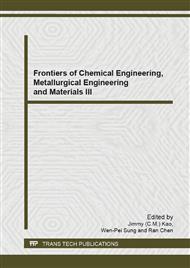[1]
W. Chen, R. Xu. Clean coal technology development in China, Energy Policy, 38( 2010)2123- 2130.
DOI: 10.1016/j.enpol.2009.06.003
Google Scholar
[2]
W. T Zhao, Y.X. Shen, K. Xiao , X. Huang. Fouling characteristics in a membrane bioreactor coupled with anaerobic-anoxic–oxic process for coke waste-water treatment, Bioresour. Technol. 101( 2010)3876-3883.
DOI: 10.1016/j.biortech.2009.12.141
Google Scholar
[3]
J.L. Wang, X.C. Quan, L.B. Wu , Y. Qian, W. Hegemann. Bioaugmentation as a tool to enhance the removal of refractory compound in coke plant waste-water, Process Biochem. 38( 2002)777-781.
DOI: 10.1016/s0032-9592(02)00227-3
Google Scholar
[4]
W. Wei, H.J. Han . Recovery strategies for tackling the impact of phenolic compounds in a UASB reactor treating coal gasification wastewater, Bioresour. Technol. 103 (2012)95-100.
DOI: 10.1016/j.biortech.2011.10.002
Google Scholar
[5]
J. Yao, Z.R. He, X.Q. Kou, Z.H. Shao, L. Jia, B.M. Li, An experimental investigation on phenol removal from coal gasification wastewater by pervaporation, J. Harbin Inst. Technol. 44 (2012)264- 267.
Google Scholar
[6]
J. Yao, Z.R. He, A.G. Luo, Q. Zhao, Z.H. Shao, L. Jia, B.M. Li . An experimental investigation on phenol wastewater treatment from coal gasification by pervaporation with NaY molecular Sieve filling membrane, J. Harbin Inst. Technol. 19 (2012).
Google Scholar
[7]
W.Q. Zhang, P.H. Rao, H. Zhang. The Role of Diatomite Particles in the Activated Sludge System for Treating Coal Gasification Wastewater, Chin. J. Chem. Eng. 17 (2009)167-170.
DOI: 10.1016/s1004-9541(09)60050-1
Google Scholar
[8]
M.A. Aboulhassan, S. Souabi, A. Yaacoubi, M. Baudu, Improvement of paint effluents coagulation using natural and synthetic coagulant aids, J. Hazard. Mater. 138(2006)40-45.
DOI: 10.1016/j.jhazmat.2006.05.040
Google Scholar
[9]
L. Yan , Y.F. Wang, H.Z. Ma, Z.P. Han. Feasibility of fly ash-based composite coagulant for coal washing wastewater, J. Hazard. Mater. 203-204 (2012) 221-228.
DOI: 10.1016/j.jhazmat.2011.12.004
Google Scholar
[10]
J.C.S.S. Menezes, R.A. Silva, I.S. Arce, I.A.H. Schneider, Production of a polyalumino-iron sulphate coagulant by chemical precipitation of a coal mining acid drainage, Miner. Eng. 23 (2010) 249-251.
DOI: 10.1016/j.mineng.2009.11.008
Google Scholar
[11]
T. Zhao K.G. Zhou,H. Wang. Research Progress in the Study of MAP Chemical Precipitation Process for Ammonium-nitrogen Containing W astewater, Safety Environ. Eng. 14(2007) 61-64.
Google Scholar
[12]
I. Stratful M.D. Scrimshaw,J. Nlester, Conditions influencing the precipitation of magnesium ammoniumphosphate, Water Res.35 ( 2001) 4191-4199.
DOI: 10.1016/s0043-1354(01)00143-9
Google Scholar
[13]
S. Zhang, C. Yao, X, Feng, Repeated use of MgNH4PO4·6H2O residues for ammonium removal by acid dipping, Desalination,170(2004)27-32.
DOI: 10.1016/j.desal.2003.12.009
Google Scholar
[14]
K. Nakata , A. Fujishima, TiO2 photocatalysis: Design and applications, J. Photochem. Photobiol. C: Photochem Rev. 13 (2012) 169-189.
Google Scholar
[15]
H. Tong , S.X. Ouyang , Y.P. Bi , N. Umezawa. Nano-photocatalytic Materials: Possibilities and Challenges, Adv. Mater. 24 ( 2012) 229–251.
DOI: 10.1002/adma.201102752
Google Scholar
[16]
M.X. Jing, C. Han, Z. Wang, and X.Q. Shen, Preparation and Photocatalytic Properties of Core-shell Nano-TiO2@ α-Al2O3 microspheres, J. Nanosci. Nanotechnol. 14(2014)6996-7000.
Google Scholar
[17]
M.X. Jing, C. Han, Z. Wang, and X.Q. Shen, Magnetic Core–Shell Nano-TiO2/Al2O3/NiFe2O4 Microparticles with Enhanced Photocatalytic Activity, J. Nanosci. Nanotechnol. 13(2013) 4949-4953.
Google Scholar


